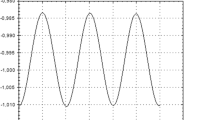Abstract
Previously, we have considered the equations of motion of the three-body problem in a Lagrange form (which means a consideration of relative motions of 3-bodies in regard to each other). Analysing such a system of equations, we considered the case of small-body motion of negligible mass m
3 around the second of two giant-bodies m
1, m
2 (which are rotating around their common centre of masses on Kepler’s trajectories), the mass of which is assumed to be less than the mass of central body. In the current development, we have derived a key parameter η that determines the character of quasi-circular motion of the small third body m
3 relative to the second body m
2 (planet). Namely, by making several approximations in the equations of motion of the three-body problem, such the system could be reduced to the key governing Riccati-type ordinary differential equations. Under assumptions of R3BP (restricted three-body problem), we additionally note that Riccati-type ODEs above should have the invariant form if the key governing (dimensionless) parameter η remains in the range 10−2
 10−3. Such an amazing fact let us evaluate the forbidden zones for Moon’s orbits in the inner solar system or the zones of distances (between Moon and Planet) for which the motion of small body could be predicted to be unstable according to basic features of the solutions of Riccati-type.
10−3. Such an amazing fact let us evaluate the forbidden zones for Moon’s orbits in the inner solar system or the zones of distances (between Moon and Planet) for which the motion of small body could be predicted to be unstable according to basic features of the solutions of Riccati-type.
Similar content being viewed by others
References
Arnold, V. I. 1978, Mathematical Methods of Classical Mechanics, Springer, New York.
Chernikov, Y. A. 1970, The Photogravitational Restricted Three-Body Problem, Soviet Astron., 14, 176.
Duboshin, G. N. 1968, Nebesnaja mehanika. Osnovnye zadachi i metody, Moscow: “Nauka” (Handbook for Celestial Mechanics, in Russian).
Ershkov, S. V. 2012, The Yarkovsky effect in generalized photogravitational 3-body problem, Planetary and Space Science, 73 (1), 221–223.
Ershkov, S. V. 2015, Stability of the Moon’s orbits in Solar system in the restricted three-body problem, Advances in Astronomy 615029, pp. 1–7 (Hindawi Publishing Corporation).
Kamke, E. 1971, Handbook for ODE, Science, Moscow.
Lagrange, J. 1873, ‘OEuvres’ edited by M. J. A. Serret. Vol. 6, published by Gautier-Villars, Paris.
Shankaran, Sharma J. P., Ishwar, B. 2011, Equilibrium points in the generalized photogravitational non-planar restricted three body problem, Int. J. Engineering, Science and Technology, 3(2), 63–67.
Sheppard, Scott S. 2015, The Giant Planet Satellite and Moon Page, Departament of Terrestrial Magnetism at Carniege Institution for Science, Retrieved 2015-03-11, See also: http://en.wikipedia.org/wiki/Solar_System.
Singh, Jagadish, Leke, Oni 2010, Stability of the photogravitational restricted three-body problem with variable masses, Astrophys Space Sci., 326, 305–314.
Szebehely, V. 1967, Theory of Orbits. The Restricted Problem of Three Bodies, Yale University, New Haven, Connecticut (Academic Press, New-York and London).
Author information
Authors and Affiliations
Corresponding author
Rights and permissions
About this article
Cite this article
ERSHKOV, S.V. Forbidden Zones for Circular Regular Orbits of the Moons in Solar System, R3BP. J Astrophys Astron 38, 5 (2017). https://doi.org/10.1007/s12036-017-9425-1
Received:
Accepted:
Published:
DOI: https://doi.org/10.1007/s12036-017-9425-1



